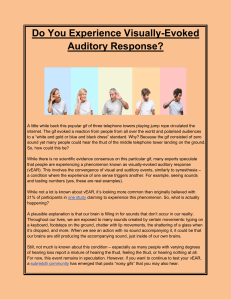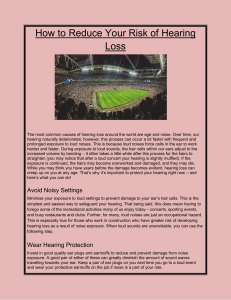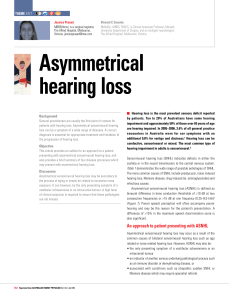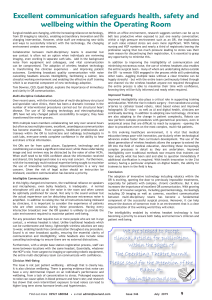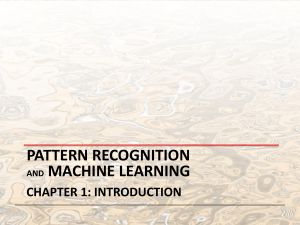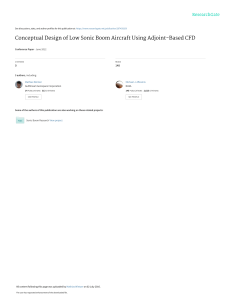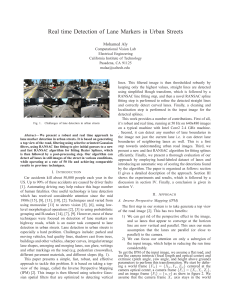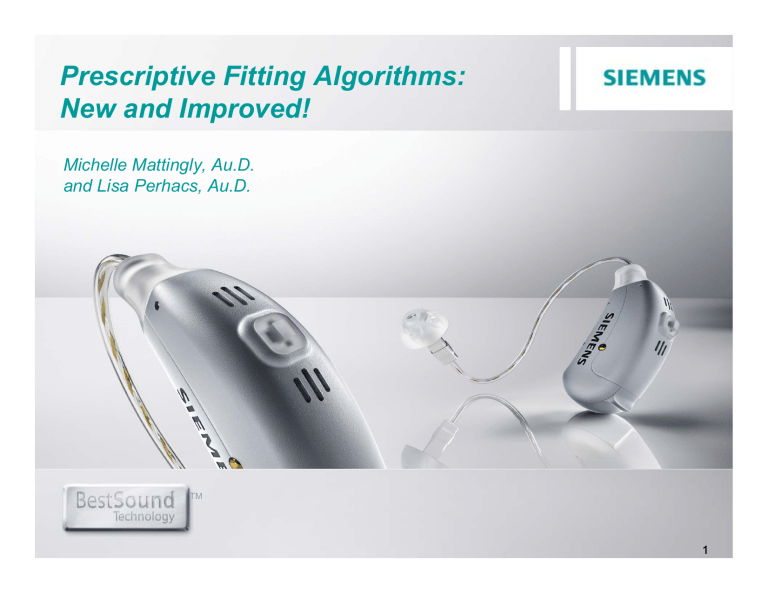
Prescriptive Fitting Algorithms: New and Improved! Michelle Mattingly, Au.D. and Lisa Perhacs, Au.D. TM 1 What is the goal of a prescriptive algorithm? • Optimize audibility • Optimize speech intelligibility • Match preferred loudness levels • Avoids loudness discomfort • Provide good sound quality 2 Why we use prescriptive algorithms (according to Harvey Dillon) • The hearing aid fitting prescription is a way of pulling together, in a very concrete and practical manner, the conclusions and implications of lots of research. • To make it as easy as possible for the clinician to get each hearing aid adjusted as right as possible as quickly as possible. The formulas attempt to summarize and quantify the best understanding of the amplification requirements of people with hearing loss. 3 DSL [i/o] • Audibility is the main goal. • Provide maximum audibility while maintaining comfortable loudness across all input levels, by providing the user with an audible and comfortable signal in each frequency region. • Device-independent enhancement of the original DSL Method provided prescriptive targets for the fitting of wide-dynamic-range compression hearing aids. • Applies loudness data and a curvilinear fit to map a wide range of input levels to target hearing instrument output levels across frequencies. It has been used in DSL software systems and in most hearing instrument and real-ear system manufacturers software implementations. 4 DSL v5 • Audible and comfortable speech cues in all listening situations is the main goal. • Less overall gain than in the previous DSL • Offers output limiting that is more appropriate for the speech signal. • Channel-matching to the specific instrument • Supports severe-to-profound hearing losses • Corrections for mixed and conductive hearing losses • Supports binaural fittings • Two rationales (Pediatric and Adult) 5 DSL v5 Child • DSL v5 Child targets are formulated for congenital hearing loss, regardless of his/her age. An adult that has a congenital hearing loss has likely been provided with amplified levels of sound that are more consistent with what the DSL v5 Child target criteria provide. • Some studies suggest that children prefer higher levels of amplified sound. • The goal was to keep the DSL v5 Child targets as close to the DSL [i/o] targets as possible. However, for more severe hearing losses, the targets for average conversational speech are lower. This is due to a correction that aims to ensure that the peaks of speech are within the patient's auditory area and not saturating the hearing aid. Overall, when the binaural correction is not applied for the fitting, the DSL v5 and DSL [i/o] targets are within 3 dB. 6 DSL v5 Adult • DSL v5 Adult targets are formulated for those who have acquired hearing loss (i.e. Adult). The Adult targets are approximately 7 dB lower than the targets for children. • Applies a different loudness perception model. Adults with an acquired hearing loss no longer perceive soft speech input sounds as efficiently as they did in their youth (“softness imperception”). • The input target range is limited to 20 dB HL (as opposed to 0 dB HL for children) for hearing aid fittings for people with acquired hearing impairment. The result is a nonlinear correction that provides a lower level of prescribed gain and compression ratio for the entire inputoutput function • The difference between the adult and child prescription decreases for people with a severe-to-profound hearing loss, which is a desired effect because it maintains audibility of speech 7 NAL – NL1 • • • • The goal is to maximize intelligibility of speech at all input levels while ensuring that the overall loudness of speech does not exceed normal overall loudness. NAL-NL1 is a threshold-based procedure that prescribes gain-frequency responses for different input levels, or the compression ratios at different frequencies, in wide dynamic range compression hearing aids. NAL-NL1 tends to prescribe less gain in the low frequencies for flat hearing loss configurations and less gain in the high frequencies for sloping high-frequency hearing loss configurations, and to generally prescribe lower compression ratios. The formula is derived from optimizing the gain-frequency response for speech presented at 11 different input levels to 52 different audiogram configurations on the basis of two theoretical formulas, a modified version of the speech intelligibility index calculation and a loudness model. 8 NAL – NL1 vs. DSL v5 • DSL v5 target is prescribed in real-ear aided gain rather than real-ear insertion gain. • DSL v5 has well integrated measurement methods that are convenient for infants & young children, without the use of correction factors. • DSL v5 does not attempt to make speech equally loud in each frequency region, although it does attempt to make it comfortably loud. • DSL v5 displays hearing loss and aided targets in SPL-o-gram. • NAL-NL1 includes specific considerations for those with severe-toprofound hearing loss. • The main objective of developing NAL-NL1 was to determine the gain for several input levels that would result in maximal effective audibility. 9 Lets kick it up a notch! 10 NEW NAL – NL2 • NAL-NL2, like NAL-NL1, is a threshold-based procedure that prescribes gain-frequency responses for different input levels, or the compression ratios at different frequencies, in wide dynamic range compression hearing aids. • The goal of NAL- NL2 remains to maximize speech intelligibility for any input level of speech above the compression threshold, while keeping the overall loudness of speech at or below normal overall loudness. • Evaluation of NAL-NL1 showed that prescribed overall gain was slightly too high for adults, particularly for higher input levels, and slightly too low for lower input levels for children. Further, the compression ratios prescribed to severe and profound hearing loss were too high. 11 NEW NAL – NL2 • NAL-NL2 utilizes improved versions of both the speech intelligibility index formula and the loudness model, as well as new speech perception data with a variety of psychoacoustic parameters, to improve the calculation of the effective audibility in the speech intelligibility index formula. • Takes into account patient’s hearing aid experience, age, gender, and tonal quality of the patient’s language. 12 Siemens CONNEXX 6.4 Prescriptive Fitting Algorithms • DSL [i/o] • DSL v5 Adult • DSL v5 Child • NAL – NL1 • NAL – NL2 Which one should you use? 13 Goal of fitting formulas • • NAL- NL1/NL2 • Goal is to maximize speech intelligibility at the listening level preferred by the wearer • Intelligibility is assumed to be maximized when all bands of speech are perceived to have the same loudness (loudness equalization) DSL [i/o]/v5 • Goal is to provide the wearer with an audible and comfortable signal in each frequency region • Does not attempt to make sounds equally loud in each frequency region 14 ConnexxFit • ConnexxFit is not a new fitting formula, but rather applies modifications to NAL-NL2 based on device specific properties and ear canal acoustics in order to optimize spontaneous acceptance. • In open fittings, ConnexxFit utilizes OPEN and OPEN4FLAT formulas to reduce the risk of feedback. • In closed fittings, ConnexxFit considers the degree of hearing loss and the selected instrument to determine the default acclimatization levels applied to NAL-NL2. • Finally, for severe to profound hearing losses, ConnexxFit defaults to Super Power-Fit to offer the perception of loudness preferred by this target group. • All these various algorithms have been developed and tested with their respective target groups in mind. It is possible, therefore, that when different hearing instruments are used for the same hearing loss, different targets may be calculated by ConnexxFit. 15 Real Ear Verification • Speech mapping is the current trend of conducting real-speech verification – but is it compatible with prescriptive fitting algorithms? • The DSL camp says it fits very well with speech mapping. DSL speech targets are meant for comparison with long-term levels of speech, in 1/3-octave bands. So, if the speech-based verification system provides this type of analysis, there is a correlation between the philosophy of DSL’s targets (to provide good audibility for speech) and what is actually measured (speech). • The NAL camp also supports verification with speech mapping. The NAL-NL1 prescription is based on maximizing speech intelligibility while controlling loudness. The derivation of the procedure explicitly uses the long-term average speech spectrum based on a multi-language international study. It is entirely reasonable to use actual speech as a test signal to see how good a job a hearing aid is doing at giving the prescribed amplification. 16 Real Ear Verification • Recorded speech is preferred because the equipment manufacturer can ensure that the long-term spectrum of the test signal is a reasonable approximation of the international average spectrum used to derive the prescription. • In a study conducted by G. Mueller, ConnexxFit does not seem to be markedly different from the commonly used NAL fitting algorithm for either speech intelligibility or paired-comparison testing. 17 Speechmapping UCLs Speechmap targets SPLogram Unaided Speech 18 Real Ear Verification – Adult vs child Adult Child Measure hearing thresholds (dB HL) Measure hearing thresholds (dB HL or dB SPL) Measure individual RECD (or estimate from age) Enter into manufacturer software (hearing aid auto adjusted to approximate prescription) Enter into manufacturer software (hearing aid auto adjusted to approximate prescription) Verify with real ear measurement Adjust amplification to better match prescription Adjust hearing aid in coupler via computer to better match prescribed coupler gain 19 Time to play with CONNEXX 20 The Audiogram 21 DSL v5 Child 22 DSL v5 Adult 23 NAL – NL1 24 NAL – NL2 25 ConnexxFit 26 Fitting Strategy National Acoustic Laboratory Australia, Harvey Dillon NAL NL1 NAL NL2 Gender Target Gain Siemens ConnexxFit Individual Real Ear Parameters Audiologist / Dispenser Supported by learning and logging feature First Fit Sound Learning 2.0 Fine Tuning Individual Fit Individual Sound Preferences Language Age Experience Hearing Instrument Parameters 27 Prescriptive Fitting Algorithms: New and Improved! Michelle Mattingly, Au.D. and Lisa Perhacs, Au.D. THANK YOU! TM 28
